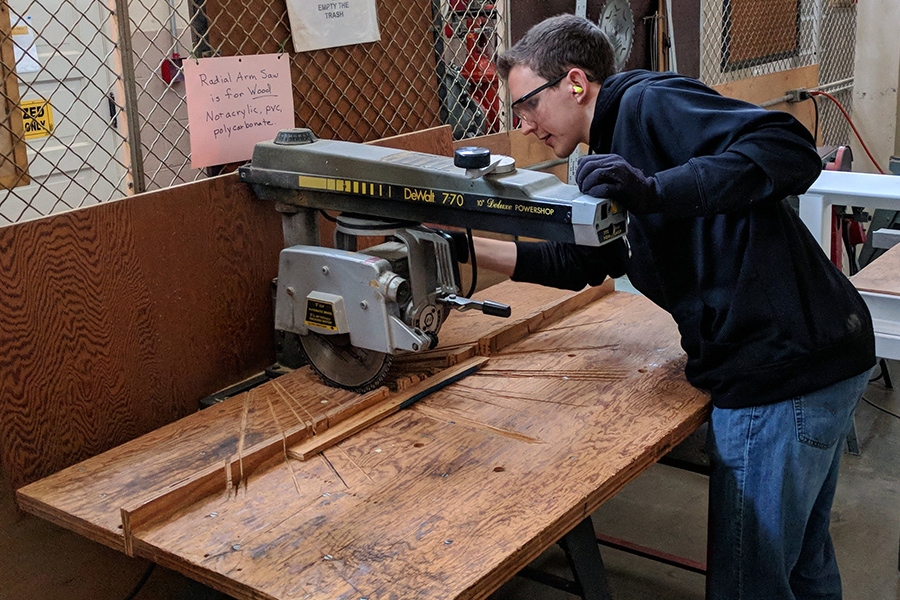Purdue Space Program Student Launch team selected for NASA competition

The Purdue Space Program Student Launch team is ready for redemption.
PSP-SL was selected to compete in the 2019 NASA Student Launch competition, one year after it was unable to participate in the challenge primarily because a delay in receiving parts meant it couldn’t build a safe high-powered rocket in time to meet NASA’s deadlines.
But AAE junior and project manager Michael Repella says PSP-SL is ready to rebound April 4-6 near NASA’s Marshall Space Flight Center in Huntsville, Ala.
PSP-SL already is ahead of schedule, even with more than six months left until the competition. The team has started building the subscale rocket, which is a smaller model of what will launch in Huntsville. Last year, the team didn’t reach that phase until January, Repella says. That gives the team confidence in this early stage of a competition that includes 52 middle school, high school and college teams from 21 states. Purdue is one of 45 college teams competing.
“There’s so many people on this team that last year, they had a disappointing moment when the supplier couldn’t come through, and all the work they put in for, probably, three quarters of an academic year just kind of got cut off,” Repella says. “I feel like the ghosts of last year can transform into something good this year.
“Purdue’s team has just had a string of bad luck actually getting to Huntsville and doing well in the competition. It’s definitely something we can do better at. I think this year we have something going well for us, starting the construction on our subscale. We have everything built for that except we haven’t mounted the fins, and the motor mount is done, but we haven’t put it into the actual rocket yet.”

Repella is one of about 30 team members as part of the PSP-SL, an organization under Purdue Students for the Exploration and Development of Space (SEDS). Fourteen members of PSP-SL are AAE students. The team elected sub-team leads that include assistant project manager Luke Perrin, avionics head Reni Patel, construction head Zach Carroll, payload head Wes O’Dell, safety head Jory Lyons, funding head Sean Heapy, and social head Harith Kolaganti. All but O’Dell are AAE students. Victor Barlow, an assistant professor in Purdue’s Polytechnic Institute, is the faculty mentor.
The group will be working on a precise schedule over the next several months, and the first significant benchmark is Nov. 2 when the team must submit its preliminary design review to NASA. The critical design review is the next key phase after that, and it’s due in the middle of winter break.
PSP-SL will have required check-ins with NASA throughout the process, and it also is hoping to have several test launches, whether via Indiana Rocketry or Midwest Power Launch.
The competition awards points based on a variety of criteria. One is altitude points, as rockets must fly at least 3,500 feet but no more than 5,500. Teams will be disqualified if their rockets don’t reach 3,500 feet or fly higher than 6,000. Repella says early simulations for PSP-SL’s rocket project an altitude of 4,360 feet.
Teams also score points for payload. College teams had to select one of two payload options: A deployable rover with a robotic arm to perform a soil sample collection or a deployable unmanned aerial vehicle that flies to a designated target after the rocket completes its flight.
PSP-SL chose the rover.
“Since we’re somewhat recovering from a dry streak in this competition, we had a lot of information on how to build the rover because it was a payload they offered in past years,” Repella says. “The UAV still is a new concept to us and other teams, so there wasn’t as much information on how to put that together. We also had a lot of team members who are really interested in robotics, so that was a big draw and we said, ‘Let’s build a rover because that’ll be fun.’”
The team will utilize the Maurice J. Zucrow Laboratories, Aerospace Science Labs, Bechtel Innovation Design Center, and Purdue BoilerMAKER Lab. The team is cutting its fins with water at BIDC.
“There’s a lot of advanced manufacturing capabilities that make this project a whole lot easier for us that might not be available for everyone,” Repella says. “I feel like being at Purdue, there’s a lot of past information and knowledge that already has been set for us in doing rocketry projects like this, especially through SEDS as a whole. They’re getting that really well set up now where it’s just a really nice community of people who know how rocketry works, are very passionate about it, and if you don’t know the answer to something, you can probably find someone inside the club who does. Even outside of that, there’s a lot of professors here, a lot of students in general who are just very passionate and very knowledgeable about that. The materials we have available here on campus are very, very conducive to this kind of project.”
